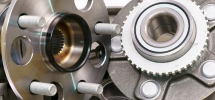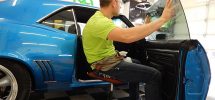With rising pressure to abide by stringent fuel economy standards from international organisations as well as governments across the world, the automotive industry is now continually looking for ways to design cars that are cleaner and more efficient and increase the fuel economies of the vehicles that they build.
The automotive industry is scrutinising effective alternatives to cut down on weight of vehicle without sacrificing durability, which is under constant pressure to adhere to increasingly strict fuel economy standards. Over time, aluminium has progressively emerged as a viable option in designing automotive trunks, doors, hoods and engines to improve gas mileage.
Indeed, changing the body from steel to aluminium is expected to cut down the weight of the car by about 15 per cent of current vehicle weight, which in turn would increase fuel economy by about 25 per cent. The decreased weight in the vehicle also improves towing, hauling, acceleration, and stopping abilities making it a more efficient vehicle overall than its steel-based counterpart. A shift from steel to aluminium in the body of vehicles by more and more companies, apart from the Ford and Audi, could push up the demand for aluminium by about 40 per cent in the upcoming years.
Aluminium is also becoming an increasingly popular material for the automotive industry due to its ability to be easily recycled. Around three-quarter of all aluminium consumed can be reused for other purposes, with reclaimed aluminium able to be recycled indefinitely – another reason why it is becoming the most popular material for die-casting automotive parts. Nearly 90 per cent of the aluminium used in vehicles is recycled at the end of its lifecycle. What’s more, aluminium, when replacing steel in today’s vehicles, could save approximately 44 million tons of CO2 emissions per year.
While aluminium has been identified as the most effective material for light-weighting, its use often involves compromising the strength of the vehicle. Structural durability of aluminium components is often considered their biggest drawback. However, even that is less of a concern as aluminium can be made nearly as structurally strong as steel through processes such as heat-treating. In fact, the strength of heat-treated aluminium alloy is capable of exceeding that of some grades of steel while still retaining its light weight and malleability. Aluminium can also be designed to absorb as much as two times the crash energy compared to mild steel.
Why Die Casting for Automotive Industry?
Alongside the automobile industry’s rising demand for aluminium parts, die-casting has attained an even higher status in recent years due to the industry’s growing use of automation, making die-casting more productive and allowing it to make a higher number of parts. This combination makes aluminium die-casting a growing draw for the automotive industry. Structural die-casting is also predicted to see growth over the forthcoming years for this very reason.
Die casting is an efficient and economical process that offers a broader range of shapes and components for automotive industry than any other manufacturing technique. The parts have long service life and may be designed to complement the visual appeal of the surrounding part. Automotive parts manufacturers like ASK Automotive can gain a number of advantages and benefits by specifying aluminium die casting parts. The advantages are:
– Die casting is able to produce automotive parts with complex shapes in closer tolerances than many other mass production processes at high speed.
– Die casting produces durable, heat resistant and dimensionally stable automotive parts, while maintaining close tolerances.
– The thin wall castings of die-cast automotive parts are stronger and lighter than those possible with other casting methods. Moreover, since die castings do not consist of separate parts welded or fastened together, the strength of automotive components after die casting is that of the alloy rather than the joining process.




